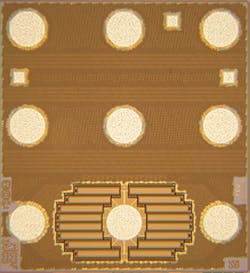On its website, there is little evidence that Cavendish Kinetics even existed before 2014. There is nothing about how it started out selling embedded memory in 1994. Its press releases only start three years ago and most references to its previous life have been cleared out.
Around 2010, it began to act more like a startup than a teenaged company. It moved its headquarters to Silicon Valley, courted investors, and repurposed its memory technology for the field of RF MEMS, which are used to tune antennas and route radio signals through smartphones and other devices.
First theorized by physicist Richard Feynman in 1959, microelectromechanical systems or MEMS are made using the same fabrication technologies as semiconductors, but contain extremely small moving parts. They were first sold in airbag sensors in 1982 and later became vital to the design of gyroscopes and accelerometers used in smartphones.
For years, the microscopic machines had been used in radio applications ranging from radar to test equipment. But it has taken years of advances in wireless communications to build the case for RF MEMS in smartphones. The technology found cheerleaders in 2012 when blogs proposed using them to improve the reception of Apple’s iPhone 4, which was notorious for dropping calls if the antenna was covered.
Now, RF MEMS appear to be maturing. On Tuesday, Cavendish said that its antenna tuners had been used in a version of the Samsung Galaxy A8 smartphone released last year. The news highlights the fact that smartphone makers are considering RF MEMS to combat the growing number and complexity of frequency bands used in 4G and 5G communications.
Cavendish has said that 10 manufacturers, including Samsung and China’s ZTE, are using its antenna tuners in 40 smartphone models, up from five in the middle of 2014. But it is behind-the-scenes conversations that bode well for RF MEMS.
“We’ve engaged with virtually everybody in the smartphone market in some way, from evaluation to design to production,” said Dan Smith, Cavendish’s vice president of sales and marketing, in an interview. “It’s very validating.”
The Cambridge University spinoff also finds validation in its $68.5 million of funding. Many of the investors are wireless chip suppliers like Qorvo, which has invested $25 million with an option to acquire Cavendish before July this year. Qualcomm, which is quietly amassing parts used in front ends, has also invested.
Brad Schaffer, a senior analyst for mobile device at research firm IHS Markit, said that Qorvo’s investment reflects how badly companies want switches that better tune, filter, and direct radio signals through the front end of smartphones and wearables. Those front ends are getting more complex as wireless networks tune into higher frequencies and devices link bands together for carrier aggregation.
Antenna tuners, also known as matchboxes, are widely used in smartphone front ends to match the impedance between the radio transmitter or receiver and its antenna. Such impedance matching is critical to maximizing antenna efficiency for every spectrum band, as signals lose strength moving through the front end into the modem.
Cavendish says that its antenna tuners can achieve lower insertion losses, higher linearity, and better reception through metal smartphone cases than conventional chips. It does so with no external components, Smith said, digitally switching between 32 capacitive states that correspond to different frequencies.
Cavendish is aiming to replace conventional chips based on silicon-on-insulator and gallium arsenide materials widely used for tuning a smartphone’s front end. In the company’s view, both exhibit higher insertion loss and lower quality factor – a measure of the energy lost in a wireless circuit – than RF MEMS.
But there is always the question of reliability with MEMS. The devices are mechanical and liable to break down faster than semiconductor devices. But Cavendish says that its antenna tuners can last through 100 billion switching cycles, making reliability into a non-issue.
Cavendish is far from the only chip maker selling RF MEMS. WiSpry sold the first RF MEMS antenna tuners to Samsung in 2012. Last December, a General Electric spinoff called Menlo Micro released an RF MEMS switch that it had originally developed for remote control circuit breakers. Though its focus is on factory control and automobiles, it plans to license the switch to smartphone makers.
There are obstacles to displacing technology as prevalent as silicon-on-insulator and gallium arsenide. And not every company has cleared them. DelfMEMS, a French start-up, folded early last year after raising $20 million in several funding rounds and announcing an RF MEMS switch in 2015.
Smith declined to say how many antenna tuners that Cavendish has shipped thus far, or how that number has changed in recent years. But the chief executive, Paul Del Santo, told industry trade publication EETimes in 2015 that he expected the company to sell 12 million parts last year.
Smith said that having a customer like Samsung was a good sign as Cavendish prepares to release its second generation of RF MEMS technology in the coming months. It will include an RF MEMS switch for smartphones and Internet of Things applications.
Correction February 8th, 2017: A previous version of this article incorrectly stated the release date of the Samsung A8 smartphone using RF MEMS antenna tuners from Cavendish Kinetics. That version of the smartphone was released in 2016, not 2015.



